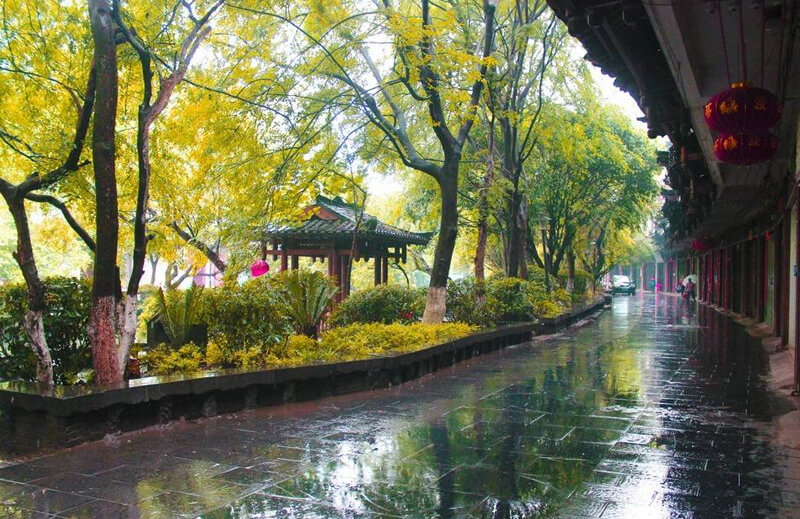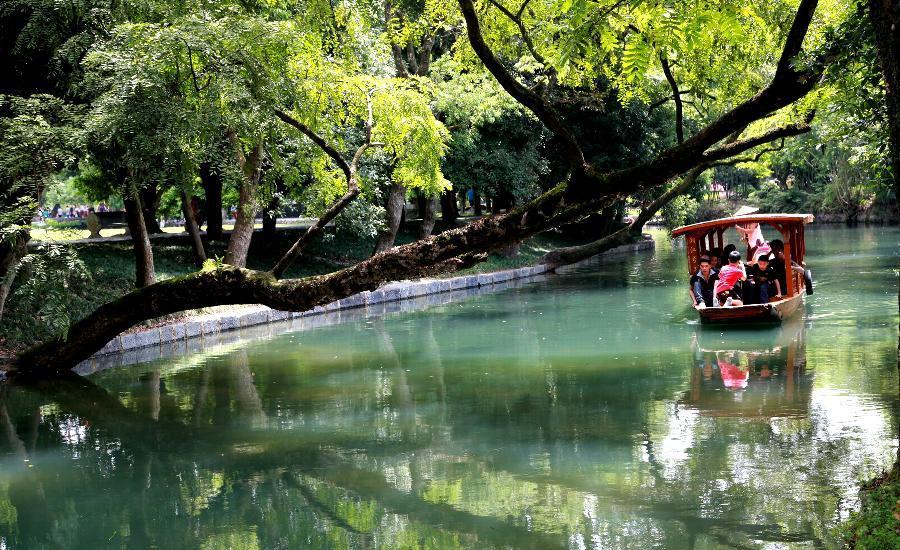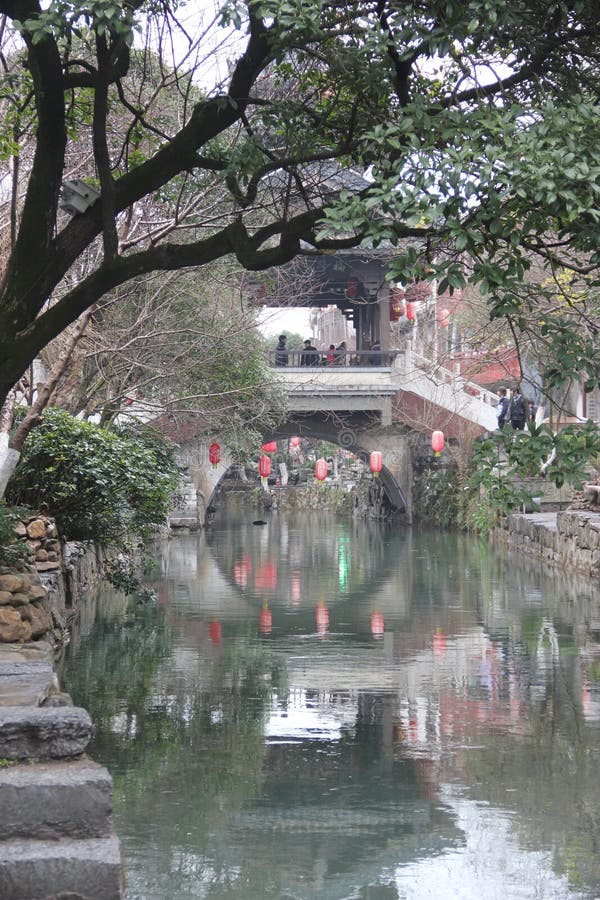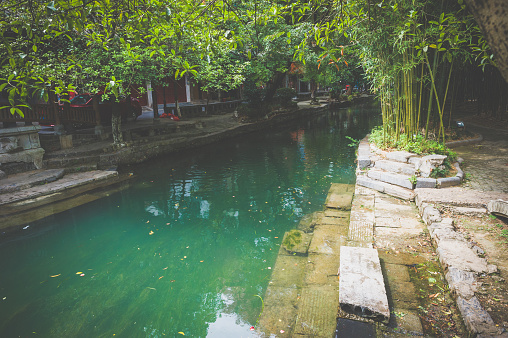Exploring Xing’An Lingqu Ancient Canal: A Hidden Gem for Adventure Seekers

An Essential Guide to Visiting Xing’An Lingqu Ancient Canal
Nestled in the picturesque Guangxi Zhuang Autonomous Region, the Xing’An Lingqu Ancient Canal is a remarkable testament to ancient engineering and ingenuity. Spanning over 36 kilometers, this historic waterway dates back to 214 B.C., making it one of the oldest canals in the world. Originally constructed under the orders of Emperor Qinshihuang, the Lingqu Canal was a strategic project designed to facilitate grain transport and military movement between Central China and the southern regions.
As you wander along this ancient route, you’ll encounter a mesmerizing blend of natural beauty and cultural heritage. The canal not only connects the Xiang River and the Li River but also serves as a vital link between the Yangtze River Basin and the Pearl River Basin, showcasing the brilliance of ancient Chinese hydraulic engineering. With its intricately designed weirs, locks, and meandering waterways, the Lingqu Canal is not just a historical site but an inspiring symbol of the innovative spirit of the Qin Dynasty.
Today, it stands as a UNESCO World Heritage Site and a beloved destination for travelers seeking to immerse themselves in China’s rich history. Whether you’re drawn by the allure of its engineering marvels, the lush landscapes that envelop it, or the stories of the past that echo along its banks, a visit to the Xing’An Lingqu Ancient Canal promises an unforgettable journey through time.
In This Guide
- An Essential Guide to Visiting Xing’An Lingqu Ancient Canal
- The Rich History and Legends of Xing’An Lingqu Ancient Canal
- Main Highlights: What You Absolutely Can’t Miss
- Planning Your Visit: A Practical Guide
- Tickets: Prices, Booking, and Tips
- How to Get There: A Complete Transportation Guide
- Local Cuisine and Accommodation Nearby
- Frequently Asked Questions
- Final Thoughts on Your Trip
The Rich History and Legends of Xing’An Lingqu Ancient Canal
Nestled in the picturesque landscapes of the Guangxi Zhuang Autonomous Region, the Xing’An Lingqu Ancient Canal is not just a feat of engineering; it is a testament to the ingenuity and ambition of ancient Chinese civilization. Constructed in 214 B.C. during the Qin Dynasty, this remarkable canal was commissioned by Emperor Qin Shihuang to facilitate the transportation of grain and supplies, particularly vital for his military campaigns in the southern territories. The canal represents a critical moment in history, linking Central China with the Lingnan region and marking the beginning of a significant era of agricultural and military expansion.
The Lingqu Canal, also known as the Dou Canal, stretches a total of 36.4 kilometers and connects the Xiang River in the north with the Li River in the south. This connection not only enabled efficient water transport but also served as a strategic military route, helping to secure the Qin Empire’s control over the Baiyue tribes in southern China. It was during this period that the canal’s innovative design was put to the test, showcasing a sophisticated understanding of hydraulic engineering that allowed for both navigation and irrigation.
This ancient engineering marvel features a unique combination of weirs, locks, and overflow dams designed to control water flow and elevation effectively. The design philosophy behind the canal was revolutionary, as it allowed for the diversion of water from one river system to another, a feat that had not been accomplished before. The clever use of natural landscapes and the integration of artificial structures exemplified the advanced hydraulic technology of the time and laid the groundwork for future canal systems across Asia.
As centuries passed, the Lingqu Canal continued to evolve, adapting to the changing needs of society. After the founding of the People’s Republic of China, the canal underwent renovations that preserved its historical significance while ensuring it remained functional. Although its role as a primary navigation route has diminished in the modern era, the canal still stands as a crucial component of the region’s irrigation and flood control systems.
Beyond its practical functions, the Lingqu Canal is steeped in cultural significance, embodying the spirit of unity and cooperation among the various ethnic groups that have inhabited the region. It is not only a symbol of agricultural prosperity but also a source of pride for local communities who recognize its role in the broader narrative of Chinese history.
Legends and folk tales have also woven themselves into the fabric of the Lingqu Canal’s history. Local stories often recount the determination and hard work of the laborers who constructed the canal, as well as the mythical beings said to guard its waters. This blend of history and legend continues to captivate the imaginations of visitors, drawing them to the serene banks of this ancient waterway.
Today, the Xing’An Lingqu Ancient Canal is more than just a historical site; it is a living legacy that reflects the ingenuity, resilience, and spirit of the Chinese people. As travelers explore its winding paths and lush surroundings, they are reminded of the profound impact this canal has had on the cultural and agricultural landscape of Southern China. Whether you are an avid historian, a nature enthusiast, or simply seeking a glimpse into the past, the Lingqu Canal offers a rich tapestry of stories waiting to be uncovered.

Xing’An Lingqu Ancient Canal.
Main Highlights: What You Absolutely Can’t Miss
The Xing’An Lingqu Ancient Canal, a marvel of ancient engineering and a UNESCO World Heritage Site, is an extraordinary destination that showcases the ingenuity and historical significance of China’s canal systems. Here are the main highlights you absolutely can’t miss during your visit:
1. The Canal Head Complex
Begin your journey at the Canal Head Complex, where the Lingqu Canal’s engineering brilliance is on full display. This area features intricate hydraulic facilities, including overflow dams and training dikes designed to control water flow and mitigate flooding. The complex is not only a functional piece of infrastructure but also offers stunning views of the surrounding landscape, making it a perfect spot for photography and reflection.
2. The South and North Canals
Explore the two main branches of the canal: the South Canal and the North Canal. The South Canal connects to the Li River, while the North Canal meanders back to the Xiang River. Witness the unique design of these waterways, which utilize curves and locks to maintain water depth and facilitate navigation. The serene beauty of the canals, framed by lush greenery and rural scenery, provides a picturesque setting for leisurely walks or boat rides.
3. Ancient Locks and Weirs
Make sure to observe the ancient locks (Doumen) and weirs that are integral to the canal’s water management system. These structures are a testament to the innovative engineering techniques of the Qin Dynasty and are among the earliest examples of their kind in the world. Understanding their function will deepen your appreciation for the canal’s historical significance and the advanced hydraulic technology of ancient China.
4. Historical Significance
Delve into the rich history of the Lingqu Canal, which dates back to 214 B.C. Created under the orders of Emperor Qin Shihuang, the canal played a crucial role in unifying southern China and securing military routes. As you walk along the canal, take a moment to reflect on how this ancient waterway shaped the region’s development and contributed to the Qin Empire’s expansion.
5. Cultural Heritage
The Lingqu Canal is not just an engineering feat; it is also a cultural symbol for the communities surrounding it. Engage with local traditions and stories that have been passed down through generations, reflecting the deep connection between the canal and the agricultural practices of the region. This cultural heritage is palpable as you meet local farmers and artisans who still rely on the canal for irrigation and water supply.
6. Aesthetic Landscapes
The winding waterways of the Lingqu Canal create some of the most beautiful landscapes in Guangxi. The combination of the canal’s curves, the surrounding mountains, and the tranquil rural environment offers numerous opportunities for stunning photographs. Don’t forget to explore the scenic viewpoints along the route that provide breathtaking vistas of the canal and its surroundings.
7. Sustainable Use of Resources
Witness firsthand how the Lingqu Canal exemplifies sustainable resource management. Even though its role in navigation has diminished, it still serves important functions for irrigation, flood control, and tourism. This adaptive reuse of ancient infrastructure highlights the canal’s ongoing relevance in contemporary society.
8. Visitor Facilities and Tours
Make the most of your visit by checking out the visitor facilities and guided tours available at the canal. Knowledgeable local guides can provide deeper insights into the canal’s history and technology, enriching your experience. Whether you choose to hike, bike, or take a boat tour, there are various ways to explore this magnificent site.
9. Local Cuisine
After a day of exploration, treat yourself to local cuisine that is heavily influenced by the canal’s agricultural surroundings. The fresh produce and regional specialties reflect the cultural essence of the area, making for a delightful culinary experience.
10. Preservation Efforts
Finally, learn about the ongoing preservation efforts aimed at maintaining the integrity of the Lingqu Canal. Engaging with local conservation projects gives you a sense of the community’s commitment to protecting this invaluable heritage site for future generations.
Visiting the Xing’An Lingqu Ancient Canal is not just about witnessing an ancient engineering marvel; it is an opportunity to connect with China’s rich history, culture, and natural beauty. Each highlight offers a unique perspective on the significance of this extraordinary waterway, ensuring a memorable experience for every traveler.

Xing’An Lingqu Ancient Canal.
Planning Your Visit: A Practical Guide
Visiting the Xing’An Lingqu Ancient Canal is a journey through time, where ancient engineering marvel meets the stunning beauty of Guangxi’s landscape. This guide provides essential information to help you make the most of your visit to this UNESCO World Heritage site.
Getting There
Location
The Lingqu Canal is located in Xing’an County, Guangxi Zhuang Autonomous Region of China. It connects the Xiang River and the Li River, making it a pivotal point in linking the Yangtze River Basin to the Pearl River Basin.
Transportation
– By Air: The nearest major airport is Guilin Liangjiang International Airport (KWL), approximately 60 kilometers (37 miles) away. From the airport, you can hire a taxi or take a shuttle bus to Xing’an County.
– By Train: Guilin has a well-connected railway system. You can take a train to Guilin and then transfer to a local bus or taxi to reach Xing’an County.
– By Bus: Several long-distance buses run between Guilin and Xing’an County, making it an affordable option for travelers.
Best Time to Visit
The ideal time to explore the Lingqu Canal is during the spring (March to May) and autumn (September to November) months when the weather is mild, and the natural scenery is at its most vibrant. Summers can be hot and humid, while winters may be chilly.
What to See and Do
Main Attractions
– Canal Head Complex: This historic site showcases the engineering genius of ancient China. Wander through the ruins and marvel at the intricate design of the canal’s hydraulic facilities.
– South Canal and North Canal: Stroll along these waterways to appreciate the serene landscape and the unique blend of nature and ancient architecture.
– Irrigation and Water Control Systems: Observe the ancient Doumen locks and weirs which are still functional, highlighting the canal’s historical importance in agriculture and transportation.
Activities
– Boating: If available, consider taking a boat tour along the canal to fully appreciate its historical significance and scenic beauty.
– Photography: The winding waterways and lush landscapes provide perfect backdrops for photography enthusiasts.
– Cultural Experiences: Engage with local communities to learn about their traditions and how the canal has influenced their way of life.
Local Cuisine
Don’t miss the opportunity to taste the local cuisine. Explore restaurants and street food stalls in Xing’an County, where you can savor regional dishes like:
– Guilin Rice Noodles: A local specialty that is both delicious and affordable.
– Zhuang-style Dishes: Experience the unique flavors of the Zhuang ethnic minority, known for their use of fresh herbs and spices.
Practical Information
Entrance Fees
Check for any applicable entrance fees at specific sites within the canal area. Many areas are free to explore, but guided tours may come at a cost.
Guided Tours
Consider joining a guided tour to gain deeper insights into the canal’s history and engineering. Local guides can provide valuable context and stories that enrich your visit.
Safety and Accessibility
– Footwear: Wear comfortable shoes, as some areas may require walking on uneven terrain.
– Weather: Be prepared for sudden weather changes by checking forecasts and dressing appropriately.
Accommodations
There are several options for staying in Xing’an County, ranging from budget hostels to mid-range hotels. Look for accommodations that offer easy access to the canal and local attractions.
Respecting the Site
As a visitor, it’s important to respect the cultural and historical significance of the Lingqu Canal. Follow local guidelines, avoid littering, and be mindful of the preservation efforts in place.
Conclusion
A visit to the Xing’An Lingqu Ancient Canal is not just a chance to explore a remarkable feat of ancient engineering but also an opportunity to experience the rich cultural tapestry of Guangxi. With its stunning landscapes, historical significance, and local charm, this destination promises an unforgettable adventure for all travelers.

Xing’An Lingqu Ancient Canal.
Tickets: Prices, Booking, and Tips
Visiting the Xing’An Lingqu Ancient Canal is a unique experience that offers a glimpse into ancient Chinese engineering and culture. As you plan your trip, here’s everything you need to know about ticket prices, booking options, and helpful tips for making the most of your visit.
Ticket Prices
When visiting the Lingqu Canal, you can expect a reasonable entry fee, which generally caters to both local and international tourists. As of 2023, ticket prices are approximately:
- Adults: CNY 40 (around USD 6)
- Students: CNY 20 (around USD 3) with valid student ID
- Children under 1.2 meters (3.9 feet): Free entry
Please note that prices are subject to change, so it’s advisable to check the official website or inquire locally for the most current information.
Booking Your Tickets
Tickets can be purchased on-site at the entrance of the Lingqu Canal. During peak tourist seasons, such as holidays and weekends, it’s recommended to arrive early to secure your entry without long waits. While advance online booking options may not be widely available, some travel agencies or local tour operators may offer bundled packages that include guided tours and transportation, which can be a convenient alternative.
Tips for Your Visit
-
Best Time to Visit: The ideal time to explore the Lingqu Canal is during the spring (March to May) and autumn (September to November) when the weather is mild and pleasant for outdoor activities.
-
Guided Tours: Consider joining a guided tour to enhance your experience. Knowledgeable guides can provide insights into the canal’s historical significance, engineering marvels, and cultural context that you may miss on your own.
-
Accessibility: The area surrounding the canal is generally accessible, but some paths may be uneven. Comfortable walking shoes are recommended.
-
Photography: Don’t forget your camera! The picturesque landscape, with winding waterways and lush greenery, provides endless opportunities for stunning photographs.
-
Stay Hydrated: Bring water, especially if you plan to walk along the canal for an extended period. There are limited facilities, so it’s best to come prepared.
-
Cultural Etiquette: Respect local customs and traditions while visiting. Be mindful of noise levels, especially in serene areas, and always ask for permission before taking photos of people.
-
Plan for Weather: Check the forecast before your visit. Bring an umbrella or rain jacket if rain is expected, and sunscreen if it’s sunny.
By planning ahead and considering these tips, your visit to the Xing’An Lingqu Ancient Canal can be both educational and enjoyable. Immerse yourself in the rich history and stunning natural beauty as you explore one of China’s remarkable cultural heritage sites.
How to Get There: A Complete Transportation Guide
Reaching the Xing’An Lingqu Ancient Canal, a marvel of ancient engineering and a UNESCO World Heritage candidate, requires a bit of travel planning. Here’s a comprehensive guide on how to get there, whether you’re coming from the bustling cities of China or arriving from abroad.
Arriving in Guangxi
By Air:
The nearest major airport to the Lingqu Canal is Nanning Wuxu International Airport (NNG), located approximately 150 kilometers away. From international destinations, you can find connecting flights to Nanning. Once you arrive, consider these options to continue your journey:
- Domestic Flights: If you’re already in China, you may have direct flights to Nanning from major cities like Beijing, Shanghai, or Guangzhou.
By Train:
For those traveling within China, high-speed trains are an excellent option. The Nanning Railway Station connects you to various cities across the country. Once in Nanning, you can take a train to Xing’an County.
From Nanning to Xing’an County
By Bus:
From Nanning, several bus companies operate routes to Xing’an County. The journey typically takes around 2-3 hours. Buses depart from Nanning’s Long-distance Bus Station. Ensure to check the schedule in advance, as it may vary.
By Car:
If you prefer more flexibility, renting a car or hiring a taxi can be an enjoyable way to see the countryside. The drive from Nanning to Xing’an County takes roughly 2-3 hours via the G72 highway, offering scenic views along the way.
Reaching the Lingqu Canal
Local Transportation:
Once you arrive in Xing’an County, the Lingqu Canal is easily accessible by:
-
Public Bus: Local buses frequently run to the canal area. Look for routes that head towards the Lingqu Canal or nearby attractions.
-
Taxi or Ride-Hailing Services: Taxis are available, and popular ride-hailing apps like Didi Chuxing operate in the region. This is a convenient option if you prefer a direct route to the canal.
Walking or Biking:
If you’re feeling adventurous, some areas around the canal are pedestrian-friendly and suitable for biking. Renting a bike in town can provide a unique way to explore the surrounding landscapes and admire the ancient canal up close.
Tips for Your Journey
-
Language: English is not widely spoken in the region, so having a translation app or a phrasebook can be helpful.
-
Local Currency: Ensure you have Chinese Yuan (CNY) for local purchases, as many places might not accept credit cards.
-
Timing Your Visit: The canal is best enjoyed in the early morning or late afternoon when the light enhances its beauty. Check local weather forecasts to plan your visit accordingly.
-
Cultural Sensitivity: As this is a site of historical importance, respect the local customs and traditions as you explore the area.
With this guide in hand, you’re ready to embark on your journey to the Xing’An Lingqu Ancient Canal. Immerse yourself in the rich history and stunning landscapes that this ancient marvel has to offer!

Xing’An Lingqu Ancient Canal.
Local Cuisine and Accommodation Nearby
Exploring the Xing’An Lingqu Ancient Canal is not just about its historical significance; it’s also an opportunity to indulge in the local flavors and relax in comfortable accommodations nearby. Here are some recommendations to enhance your visit.
Local Cuisine
-
Guilin Rice Noodles (桂林米粉)
A must-try when in the Guangxi region, these rice noodles are served in a savory broth and topped with various ingredients like pickled vegetables, peanuts, and meat. Look for local eateries in Xing’an County where you can enjoy this dish with a unique twist that reflects the area’s culinary heritage. -
Luosifen (螺蛳粉)
This spicy and sour rice noodle dish features river snails and a medley of fresh herbs and vegetables. The aromatic broth and its distinctive flavor are a favorite among locals and a delightful experience for visitors seeking authentic Guangxi cuisine. -
Steamed Fish
Given the proximity to the water, fresh fish is a staple in local diets. Try the steamed fish prepared with ginger and scallions, which is both healthy and flavorful. Many restaurants along the canal serve this dish with a side of seasonal vegetables. -
Zhuang Cuisine
The Zhuang ethnic minority, native to this region, has a rich culinary tradition. Sample dishes like bamboo rice wrapped in leaves, and enjoy the unique flavors and cooking techniques that have been passed down through generations. -
Local Snacks
Don’t miss out on local snacks such as Tuan Tuan (团团), a type of sticky rice ball filled with sweet or savory fillings, and Yaozi (腰子), fried dough twists that are crispy and addictive.
Accommodation Nearby
-
Lingqu Ancient Canal Hotel
Nestled close to the canal, this hotel offers modern amenities with traditional Chinese decor. Enjoy comfortable rooms, a restaurant serving local dishes, and easy access to the canal for leisurely strolls or boat rides. -
Xing’an Eco-Lodge
For travelers seeking a more immersive experience, this eco-lodge combines sustainability with comfort. Surrounded by nature, it provides an opportunity to unwind, offering outdoor activities and locally-sourced meals prepared with fresh ingredients. -
Guilin Riverside Boutique Hotel
Located a short drive from the canal, this boutique hotel boasts stunning river views and beautifully designed rooms. The on-site restaurant features a variety of local and international dishes, ideal for unwinding after a day of exploration. -
Traditional Guesthouses
Experience local hospitality by staying in a traditional guesthouse. Many families offer rooms in their homes, providing an authentic glimpse into Zhuang culture and cuisine while keeping you close to the canal’s charm. -
Luxury Resorts
For those looking for a touch of luxury, several resorts in the nearby Guilin area offer upscale accommodations, spa services, and gourmet restaurants featuring both local and international cuisines.
Visiting the Xing’An Lingqu Ancient Canal provides not just a journey through history but also a chance to savor the rich culinary landscape and enjoy a variety of accommodations that cater to all tastes and budgets. Be sure to take your time, explore the local flavors, and relax in the serene surroundings this remarkable region has to offer.

Xing’An Lingqu Ancient Canal.
Frequently Asked Questions
Frequently Asked Questions
1. Where is the Xing’An Lingqu Ancient Canal located?
The Lingqu Canal is situated in Xing’an County within the Guangxi Zhuang Autonomous Region of China. It connects the Xiang River and the Li River, playing a crucial role in linking the Yangtze River Basin and the Pearl River Basin.
2. What is the historical significance of the Lingqu Canal?
Constructed in 214 B.C. during the Qin Dynasty, the Lingqu Canal is one of the earliest and most significant examples of ancient canal construction. Its design and engineering reflect the advanced hydraulic technology of its time, contributing to the military and agricultural expansion of the Qin Empire in the Lingnan region.
3. How long is the Lingqu Canal, and what are its main features?
The canal stretches approximately 36.4 kilometers and includes several key projects such as the Canal Head Complex, the South Canal, and the North Canal. It was ingeniously designed to elevate water levels using weirs and includes a unique system of locks for navigation.
4. What can I do at the Lingqu Canal?
Visitors can explore the scenic beauty of the canal, enjoy hiking and biking along its paths, and appreciate the historical and cultural significance of this ancient engineering marvel. Photography opportunities abound, especially with the picturesque landscapes surrounding the canal.
5. Is the Lingqu Canal accessible for tourists?
Yes, the Lingqu Canal is accessible to tourists. There are designated walking paths, and local guides are available to provide insights into its history and engineering. However, it’s advisable to check local resources for the latest visitor information and any potential access restrictions.
6. Are there any facilities nearby for tourists?
Yes, there are local amenities such as restaurants, shops, and accommodations in Xing’an County. Many visitors choose to stay in nearby towns to fully explore the canal and its surroundings, offering a chance to experience local culture and cuisine.
7. What is the best time to visit the Lingqu Canal?
The best time to visit is during the spring (March to May) and autumn (September to November) when the weather is mild and the scenery is particularly beautiful. These seasons also offer clear skies and vibrant landscapes, enhancing the overall experience.
8. Can I learn more about the canal’s history and technology during my visit?
Absolutely! Many local guides offer tours that delve into the engineering techniques used in the canal’s construction, its historical context, and its role in ancient Chinese civilization. Additionally, informational plaques and exhibits are often available along the canal, providing further insights for visitors.
Final Thoughts on Your Trip
As you conclude your journey along the Xing’An Lingqu Ancient Canal, take a moment to reflect on the profound historical and cultural significance of this extraordinary feat of engineering. Spanning over two millennia, this ancient waterway is not just a conduit of water, but a testament to the ingenuity and resilience of the human spirit. As you traverse its winding paths, imagine the countless individuals who have relied on this canal for sustenance and connection throughout history.
The Lingqu Canal offers a unique glimpse into the harmonious relationship between nature and human innovation. Its intricate design showcases a remarkable understanding of hydraulic technology that has stood the test of time, serving as both a vital transportation route and an agricultural lifeline. Surrounded by the breathtaking landscapes of Guangxi, the canal invites you to explore its serene beauty, where every bend and ripple tells a story of a bygone era.
Whether you’re wandering along its banks, marveling at its engineering marvels, or simply soaking in the tranquil atmosphere, the Lingqu Canal is sure to leave an indelible mark on your heart. As you depart, carry with you the spirit of connection that this remarkable site embodies, and let it inspire your future travels. The Lingqu Canal is more than a destination; it is a celebration of humanity’s enduring quest for harmony with nature and progress through innovation. Safe travels as you continue your adventure!